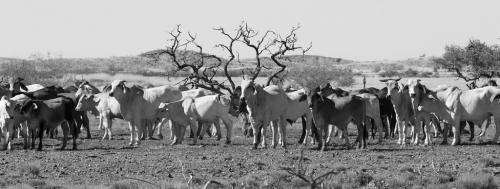Directing cattle to graze on dry land: recommendations

A group of scientists and pastoralists is trialling a series of measures to modifying cattle grazing behaviour they term "Rangelands Self Shepherding".
Animal nutritionist at CSIRO Perth, Dr Dean Revell says after restocking, cattle tend to graze a limited part of the station near dry season waterpoints, and tend to eat plants they already know.
Without further management, this leads to overgrazing in patches, with individual animal's nutritional needs not always being met.
"Using behaviour of animals to our advantage is our underlying principle," he says.
"Lowering stress levels in animals broadens their willingness to try new things.
"Animals can be encouraged to use areas that become underutilised and avoid over utilisation.
"You've got to allow rest and recovery periods for parts of the landscape.
"Part of what we want to do is not just bring animals to a new area but hold them there through influence, not just through the control of a fence."
Together with NSW famer Bruce Maynard and US animal behaviourist Prof Fred Provenza, they recommend several cattle management strategies for dry season pastures in unfenced lands.
Firstly, water points are left on for a limited time, encouraging cattle to thoroughly graze surrounding pasture.
When a water point is switched off, cattle move elsewhere, allowing pasture to regenerate.
Secondly, Dr Revell says placing nutritional supplements (aka "putting lollies out") at strategic points also encourages this localised grazing.
He says while it is important, when choosing supplements, to analyse and remedy any dietary deficiencies the cattle have, it also encourages self-shepherding.
"Animals will seek out something they need with much greater vigour and effort than something that they're already getting," he says.
Thirdly, they recommend never re-stocking a station with an entirely new herd.
He says "naive" cattle in unfamiliar country are less inclined to try eating new plants and grazing new pastures.
Older more experienced cattle play an important coaching role for younger beasts.
Fourthly, strategically placed markers such as roadways and small lengths of fence tend to direct cattle movement towards new pastures.
Dr Revell says it is important that none of these new practices involves extra work, as cattlemen are busy enough already.
"It has to be low cost and it has to be with minimal hours of labour too," he says.
The group will host workshops for pastoralists in Broome on 8–9 May 2014.
It aims to undertake federally funded trials with three selected pastoral groups.
Provided by Science Network WA


















